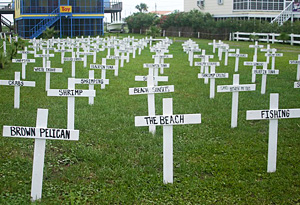Oil and Water

Photo: Suzannah Evans, Oceana.org
Environmental journalist Simran Sethi takes a break from blogging about making her home earth-friendly to investigate the impact of the devastating BP oil spill in the Gulf of Mexico, and what you can do about it.
"The major difference between a thing that might go wrong and a thing that cannot possibly go wrong is that when a thing that cannot possibly go wrong goes wrong it usually turns out to be impossible to get at or repair."— Douglas Adams
I did not want to write this post. I hoped that I would return from my much-needed holiday in Turkey and BP Chief Operating Officer Doug Suttle's comment about the oil spill slowing to a "relative trickle" would be true. I prayed there would be no words left to say about the massive devastation in the Gulf of Mexico because we would be on the other side of the challenge, close to resolution.
That has not yet happened.
According to the National Oceanic and Atmospheric Administration, 35,000-60,000 barrels of crude oil continue to gush across 78,000 square miles in the Gulf of Mexico each day. To give you an idea: 78,000 square miles is an area roughly half the size of California—or the same size as Chernobyl.
It is hard to conceive of a spill of this size—and to fight against feelings of helplessness and overwhelm. The stunning map at IfItWasMyHome.com helped me better understand the extent of the damage: If the Deepwater Horizon rig were centered over my town of Lawrence, Kansas, the spill would stretch across the state into the city of Wichita, seep upwards into Nebraska, and continue east into Missouri.
As for feelings of helplessness and overwhelm, I am still working on it. For me, it starts with getting a better understanding of how those directly affected by the spill are doing. We may have our own ideas about President Obama's speech, BP's $20 billion compensation package, and the legacy of offshore drilling, but how are they received by those who feel the immediate loss of fishing, beaches and marine life?
In my interview (edited by Jessica Sain-Baird) with Jackie Savitz, senior campaign director for ocean conservation non-profit Oceana, she explains what we aren't seeing on the news and why offshore drilling must be stopped.
Listen to Simran's interview with Jackie Savitz now.
Please note, I'm writing this post on Day 62, and featuring an audio interview recorded on Day 58. I hope that by the time you read and listen, we'll be just a little closer to resolution. I'll follow up with what each of us can do to help make things better in my next post and continue to update you on Twitter @simransethi.
Simran
Simran Sethi is an award-winning journalist and associate professor at the University of Kansas School of Journalism and Mass Communications. For more information on Sethi, visit SimranSethi.com and follow her on Twitter @simransethi.
Keep Reading:
Aboard the Plastiki—a mission to raise awareness
What is the Great Pacific Garbage Patch?
A third-generation Cousteau brings sea advocacy into the 21st century



